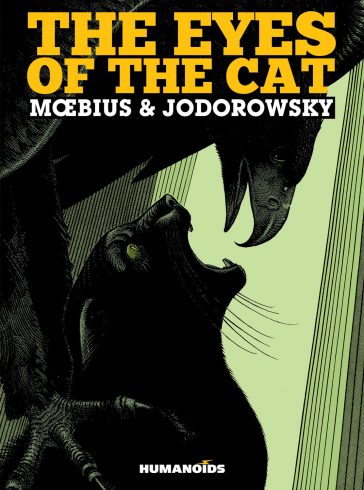 By ALEJANDRO JODOROWSKY, JEAN “MOEBIUS” GIRAUD (Humanoids; 1978/90/2013)
By ALEJANDRO JODOROWSKY, JEAN “MOEBIUS” GIRAUD (Humanoids; 1978/90/2013)
When contemplating this horrific graphic novel I find that several terms invariably recur, namely bizarre, dreamlike, enigmatic and surreal. Created in the late 1970s, it was the premiere collaboration between scripter Alejandro Jodorowsky and artist Jean “Moebius” Giraud, who would go on to create the iconic INCAL comic series.
That comic was born out of the wreckage of Jodorowsky’s ambitious attempt at filming DUNE (upon which Moebius labored), from which THE INCAL’s narrative and imagery sprung. Again, though, THE EYES OF THE CAT—initially published in French (and distributed for free), followed by a 1990 English translation in GAUNTLET #4 and this standalone publication in 2013—appeared first, serving as the inception of a longtime writer-artist partnership that, according to Jodorowsky, came about “due to magical forces beyond our control.” It may well be the single most bizarre work ever perpetrated by either Jodorowsky or Moebius, and that, I can assure you, is no small claim!
Presented in black-and-white on yellow paper (a format that has remained constant throughout THE EYES OF THE CAT’s publication history), it depicts a strangely deserted (post-apocalyptic?) city, and a boy residing in an upper floor of a monastery therein. Initially we see the boy only in silhouette, artfully framed by a vast window—everything in this comic, understand, is resolutely measured and precise.
The boy, it transpires, is in telepathic contact with a malevolent hawk named Meduz. Their object is a cat seen wandering through the deserted city that Meduz, on the boy’s orders, kills, after which it yanks out the critter’s eyes. The boy wants the eyes for reasons we don’t learn until the suitably gruesome final panels.
Any number of mythological references can be discerned here—the fact that the hawk’s name is “Meduz,” as in Medusa, is evidently quite significant in this regard—as can the type of religio-poetic content in which Jodorowsky tends to specialize. Here, though, Jodorowsky’s imagination is put to much darker, scarier ends than in his subsequent narratives.
The pen-and-ink drawings by Moebius are of course what really put this work over the top. Perfectly proportioned, graphically bold and (as previously mentioned) mathematically precise, the artwork is, simply, brilliant, showcasing one of two exceptional artists at the pinnacle of their respective powers.
